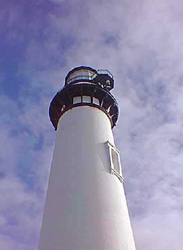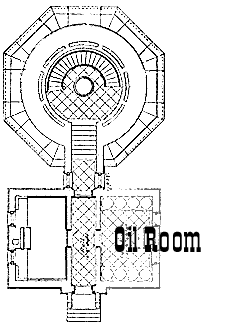Lighthouse Tower

The glass-enclosed lantern room at the top of the tower contains the lighthouse's original first-order Fresnel ("fray-nell") lens, named after Augustin Fresnel, the French engineer who invented the system in 1826, the lens consists of glass prisms and magnifiers that bend and concentrate light from a central lamp into horizontal beams that can be seen many miles at sea. The Pigeon Point lens has 1,008 prisms mounted in 24 racks. The prisms and racks combine to become a brass assembly that is 16 feet high, 6 feet in diameter, and weighs 2,000 pounds. The lens is mounted on wheels and the turning-mechanism is powered by a gravity-driven clockwork system, similar to a "grandfather clock." The entire lens assembly rotates once every four minutes to produce a flash of light every 10 seconds.
The lamp used in 1872 generated light using a burner made up of five concentric, open-flame wicks, fueled by lard oil. It produced 70,000 candlepower. Later, kerosene was burned in a similar open-flame, multiple-wick lamp. Next, a vaporized oil system, similar to lanterns used in camping, was installed. Finally, in 1926, electricity was used to illuminate the lighthouse lens. Today's light is an externally mounted rotating aero beacon that sends a 680,000 candlepower beam 20 miles out to sea every 10 seconds. Ship captains consult manuals called "Light Lists" to identify lighthouses by their patterns of light and dark called their "characteristics."

This is the floor plan of the tower, work room, and oil room. Both the work room (left side), and the oil room (right side), have small fireplaces. The work room was used by the keepers for repairing equipment, updating logs, and other maintenance and administrative chores. The oil room was used to store 100 pound butts of lard oil. Each night the keeper, or his assistant, would draw off a sufficient amount of oil for a night's service. Then, they would carry the fuel up the 136 stairs to the lens room. The 100 pound butts were supplied from the Lighthouse Service's depot in San Francisco.
Around 1888, the lard oil lamp was replaced by one that burned kerosene. In the early 1900s, a separate oil bunker was built away from the tower. The separate oil bunker was a safety precaution to prevent damage to the tower in case of fire or explosion by the more volatile kerosene fuel.
